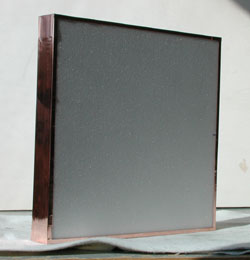Light Given New Direction

Focusing light is normally the province of lenses and mirrors. But making small, lightweight focusing devices that can interface with electronic components requires a different approach. Now researchers have used a slab of a new kind of material to focus diverging electromagnetic waves into a narrow cone. The result, published in the 18 November print issue of PRL, may have applications in space communications, fiber optics, and infrared lasers.
A medium’s optical index describes the way in which it bends light and, in normal materials, is directly related to the speed that light travels: larger index means slower speed. When light reaches the boundary between two materials at an angle, it bends toward the perpendicular direction if the second medium has a higher optical index than the first. Lenses make use of this property to focus visible light, but they can’t be given arbitrary size and shape and so are not ideal for electronic applications. And many technologies, including antennas for satellite uplinks and cellular communications, work in the microwave range. Materials called photonic crystals have the potential to focus visible light, but may not work as well with microwaves.
In contrast, microwaves are the best regime for metamaterials–combination materials engineered from macroscopic chunks of pure metal and other substances. Researchers have reported creating metamaterials with a negative optical index, which bends light the “wrong” way [see Focus story]. But Stefan Enoch and his coworkers at the Fresnel Institute in Marseille, France, desired instead a positive but very small index, much less than that of air. If a source within such a material radiated light in many directions, the light would encounter a huge relative index when it emerged at a surface. The radiation would be narrowly focused in one direction, perpendicular–or “normal”–to the interface. “Even [waves leaving at a] grazing angle are refracted in a direction close to normal,” Enoch says. Such a small index does not mean the speed of light exceeds that of a vacuum: this rule of thumb breaks down in metamaterials.
The group punched a lattice of 5-millimeter-wide square holes into sheets of copper and then embedded several such sheets into a piece of foam, creating a spaced-out stack. They wedged a microwave-producing cable between two of the copper grids and measured the spectrum of emitted microwaves at several distances from the material. The emission was confined to a cone about 10 degrees wide. Besides antennas for space-based systems, other conceivable applications include transmitting more light from light-emitting diodes to fiber optic cables and creating cheap sources of coherent thermal radiation, or infrared lasers, from hot materials.
“What is important about this paper is not the specific increase in gain associated with the antenna–although this is impressive,” says David Smith of the University of California in San Diego, but rather the way that the metamaterial reduces the complexity of the design. He notes that many researchers want to streamline and improve devices using metamaterials, and this work “represents a compelling example of that process.”
–JR Minkel
JR Minkel is a freelance science writer in New York City.
More Information
Focus story on left-handed materials.


